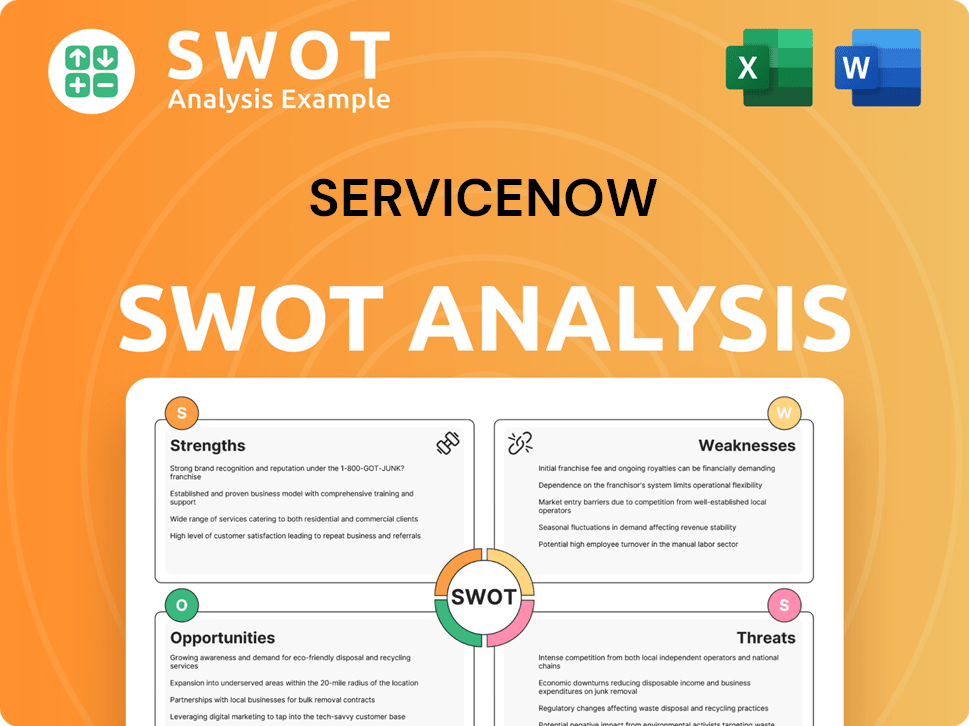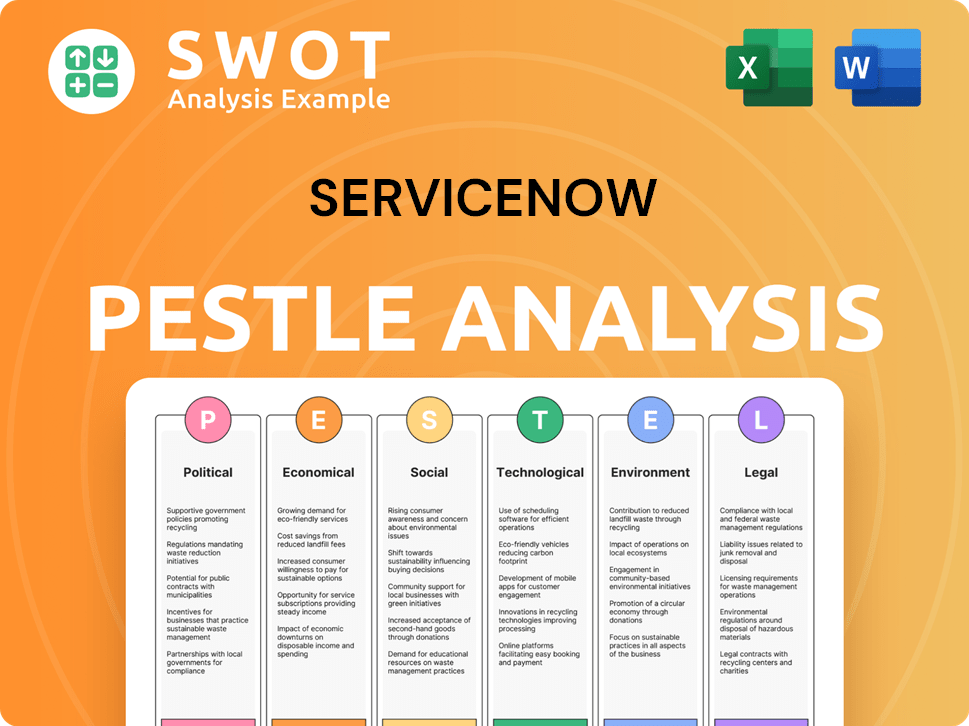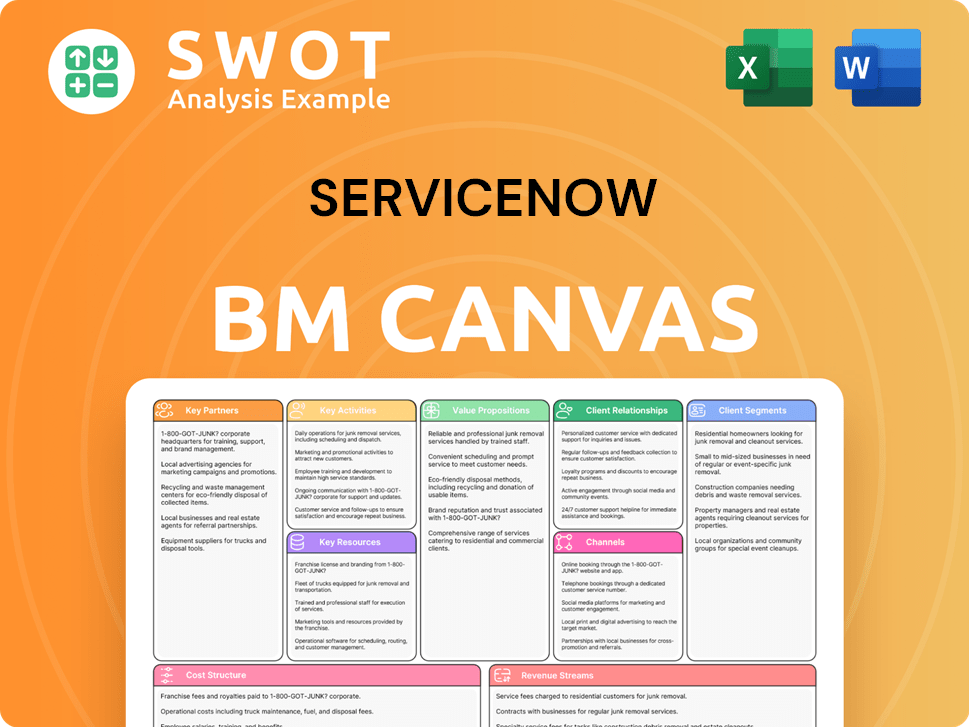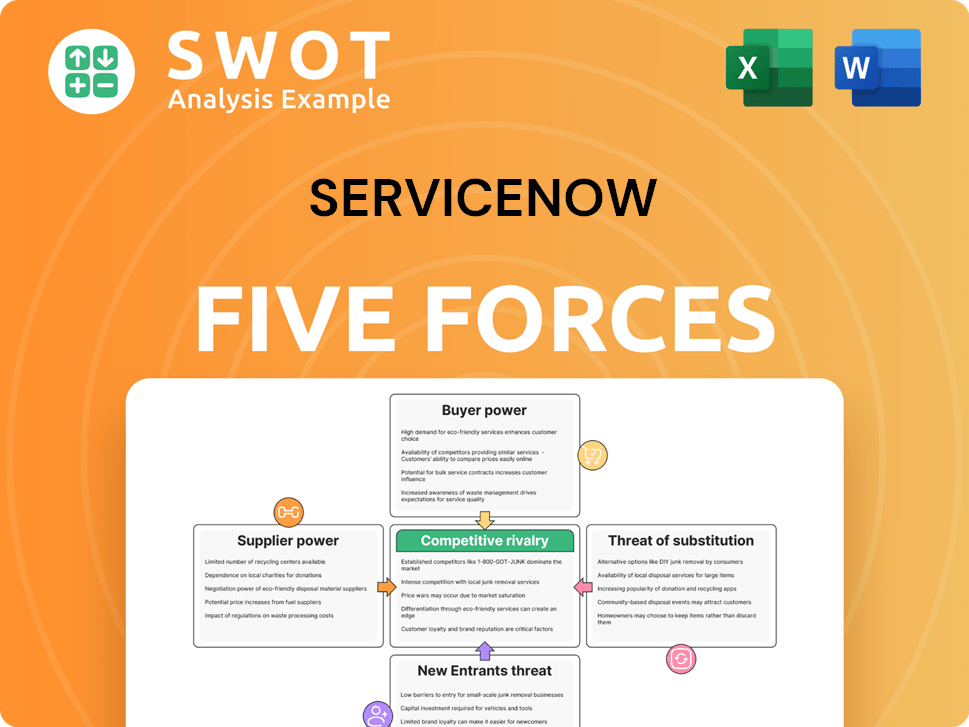ServiceNow Bundle
How Does ServiceNow Revolutionize Business Operations?
ServiceNow has become a powerhouse in the enterprise software landscape, transforming how businesses operate through its innovative digital workflow solutions. This cloud-based platform is reshaping industries by streamlining IT, employee, and customer workflows, resulting in substantial gains in efficiency and productivity. Discover how ServiceNow is driving digital transformation across the globe.

To truly grasp ServiceNow's impact, it's essential to understand its core functionalities and business model. From ServiceNow SWOT Analysis to its features for IT service management and customer service portals, this analysis will provide a comprehensive overview. We'll explore how the ServiceNow platform empowers organizations to enhance their operations and achieve their strategic goals through cloud computing and intelligent automation, including how to learn ServiceNow and its integration capabilities.
What Are the Key Operations Driving ServiceNow’s Success?
The core value proposition of the company lies in its ability to offer a unified, cloud-based platform designed to automate and optimize digital workflows across an enterprise. The company's main offering, the Now Platform, serves as the foundation for a suite of solutions. These solutions span IT Service Management (ITSM), IT Operations Management (ITOM), Human Resources Service Delivery (HRSD), Customer Service Management (CSM), and Security Operations (SecOps), among others.
These solutions serve a diverse customer base, ranging from small and medium-sized businesses to large multinational corporations. The company's solutions are used across various sectors, including financial services, healthcare, government, and technology. The platform's focus on streamlining processes makes it a key player in the realm of digital transformation.
Operationally, the company utilizes a multi-instance cloud architecture, ensuring data isolation and high availability for its customers. The platform is designed for extensibility, allowing customers and partners to build custom applications and integrations. Continuous technology development is a priority, with significant investments in research and development, particularly in areas like artificial intelligence (AI) and machine learning (ML) to enhance workflow automation and predictive capabilities.
The ServiceNow platform is a cloud-based platform that helps businesses manage digital workflows. It provides a single platform for various departments, including IT, HR, and customer service. The platform is designed to improve efficiency and reduce costs through automation.
Key features include IT service management, IT operations management, and customer service management. It also offers application development capabilities, allowing businesses to build custom applications. ServiceNow's features are designed to streamline processes and improve user experience.
ServiceNow's ITSM solutions automate and streamline IT processes. It helps manage incidents, problems, and changes efficiently. This leads to faster resolution times and improved IT service delivery.
CSM solutions enhance customer service operations. It provides a centralized platform for managing customer inquiries and issues. This improves customer satisfaction and loyalty.
Sales channels primarily involve a direct sales force supported by a strong partner ecosystem. Customer service is delivered through a tiered support model, professional services, and a community portal. This ensures comprehensive support for all users of the ServiceNow platform.
- Direct Sales Force: The company employs a direct sales force to engage with and secure large enterprise clients.
- Partner Ecosystem: A robust partner network of system integrators, resellers, and technology partners expands market reach.
- Customer Support: A tiered support model, along with professional services and a community portal, provides extensive customer assistance.
- Community Portal: A vibrant online community fosters user engagement and knowledge sharing.
ServiceNow SWOT Analysis
- Complete SWOT Breakdown
- Fully Customizable
- Editable in Excel & Word
- Professional Formatting
- Investor-Ready Format

How Does ServiceNow Make Money?
Understanding the revenue streams and monetization strategies of a company like ServiceNow is crucial for grasping its financial health and growth potential. ServiceNow, a leading provider of cloud-based workflow solutions, has established a robust business model centered on recurring revenue and strategic expansion.
The company's ability to generate consistent revenue and adapt to market demands is a key factor in its success. This approach allows ServiceNow to maintain a strong financial position and invest in further innovation and market expansion.
ServiceNow primarily relies on subscription-based services. In the first quarter of 2024, approximately 95% of its total revenue came from these subscriptions, amounting to $2.52 billion. The remaining revenue is generated from professional services, including implementation, training, and consulting. This subscription model provides a predictable and sustainable revenue stream, reflecting the long-term value and customer retention of the ServiceNow platform.
ServiceNow employs several monetization strategies to maximize revenue and customer value. These strategies include tiered pricing, cross-selling, and upselling to increase the average contract value and expand its customer base. These approaches are designed to ensure that the company continues to grow and offer value to its customers.
- Tiered Pricing: ServiceNow offers different pricing tiers based on the number of users or the level of functionality. This allows customers to select the plan that best suits their needs and budget.
- Product Editions: Different editions of products, such as Standard, Professional, and Enterprise, are available to cater to various customer requirements.
- Cross-selling and Upselling: Encouraging existing customers to adopt additional modules or upgrade to higher-value offerings is a key strategy. For example, customers using ITSM might expand to HRSD or CSM solutions.
- Platform Expansion: ServiceNow focuses on expanding its platform capabilities, particularly with new AI-powered features, to drive further adoption and increase average contract values.
- Strategic Acquisitions: Acquisitions contribute to revenue diversification by integrating new capabilities and expanding market reach. This is a key component of the Growth Strategy of ServiceNow.
ServiceNow PESTLE Analysis
- Covers All 6 PESTLE Categories
- No Research Needed – Save Hours of Work
- Built by Experts, Trusted by Consultants
- Instant Download, Ready to Use
- 100% Editable, Fully Customizable

Which Strategic Decisions Have Shaped ServiceNow’s Business Model?
The journey of ServiceNow has been marked by significant milestones and strategic moves that have shaped its current market position. A key moment was its initial public offering (IPO) in 2012, which provided the capital for accelerated growth and platform development. The company has consistently expanded its product portfolio beyond IT service management (ITSM) to encompass HR, customer service, security, and low-code application development, transforming it into a comprehensive enterprise workflow platform.
Strategic partnerships with major cloud providers and system integrators have been instrumental in expanding its reach and adoption. ServiceNow has also invested heavily in innovation, particularly in integrating artificial intelligence and machine learning into its platform to enhance automation and provide predictive insights. This technological leadership is a core competitive advantage. The company faces intense competition from established enterprise software vendors and niche players, as well as the need to continuously adapt to evolving customer demands and technological shifts.
ServiceNow's competitive edge is further solidified by its strong brand recognition, the stickiness of its platform due to deep integration into customer operations, and a robust ecosystem of developers and partners. The company continues to adapt by focusing on industry-specific solutions and expanding its global presence, particularly in emerging markets. To understand more about their approach, you can explore the Marketing Strategy of ServiceNow.
The IPO in 2012 was a pivotal event, providing the financial resources for expansion. Continuous expansion of the product portfolio beyond ITSM to include HR, customer service, and security. Strategic partnerships with major cloud providers expanded reach and adoption.
Investment in AI and machine learning to enhance automation and predictive insights. Focus on industry-specific solutions to cater to diverse customer needs. Expanding global presence, especially in emerging markets, to capture new growth opportunities.
Strong brand recognition and platform stickiness due to deep integration. A robust ecosystem of developers and partners supports and extends the platform. Continuous innovation in AI and machine learning provides a technological advantage.
Intense competition from established enterprise software vendors. The need to continuously adapt to evolving customer demands. Technological shifts require ongoing innovation and platform updates.
In Q1 2024, ServiceNow reported subscription revenues of approximately $2.4 billion, a 24% increase year-over-year. The company's market capitalization is consistently high, reflecting strong investor confidence. ServiceNow continues to demonstrate robust growth in a competitive market, driven by its focus on the ServiceNow platform and digital transformation solutions.
- The company's focus on cloud computing and digital transformation continues to drive growth.
- ServiceNow's investments in AI and machine learning are enhancing its platform's capabilities.
- Strategic partnerships and acquisitions are expanding its market reach and service offerings.
- The company's commitment to innovation is a key factor in maintaining its competitive edge.
ServiceNow Business Model Canvas
- Complete 9-Block Business Model Canvas
- Effortlessly Communicate Your Business Strategy
- Investor-Ready BMC Format
- 100% Editable and Customizable
- Clear and Structured Layout

How Is ServiceNow Positioning Itself for Continued Success?
The company holds a strong position in the IT Service Management (ITSM) market and is a key player in digital workflow automation. Its success is evident in its financial performance, with subscription revenues of $2.52 billion in Q1 2024, marking a 25% year-over-year growth on a constant currency basis. The company's high customer retention rate, with a renewal rate of 99% in Q1 2024, highlights the value customers find in the platform.
The company faces risks such as increasing competition from other enterprise software providers, potential economic downturns influencing IT spending, and the challenges of integrating new technologies. Regulatory changes in data privacy and cloud security also present potential challenges. The company is focusing on expanding its AI capabilities, particularly with its Now Assist generative AI solution, to drive further automation and innovation across its platform.
The company is a leader in the ITSM sector and a significant participant in the digital workflow automation field. Its platform offers a comprehensive solution for managing IT services. The company competes with major players like Salesforce and SAP, as well as specialized automation tools.
Key risks include intensifying competition, economic downturns, and challenges in integrating new technologies. Regulatory changes related to data privacy and cloud security also pose potential headwinds. The company must navigate these challenges to maintain its market position.
The company is focused on expanding its AI capabilities and driving automation. The company aims to continue its strong growth trajectory, projecting subscription revenue of $10.550 billion to $10.560 billion for the full year 2024. It aims to deliver increasing value through AI-powered workflows.
The company's strategy involves expanding its AI capabilities, entering new industries, and strengthening customer relationships. This approach is designed to sustain and expand its monetization capabilities. Understanding the Competitors Landscape of ServiceNow is crucial for assessing its long-term prospects.
The company offers numerous benefits for businesses, including improved IT efficiency and enhanced customer service. The platform's features and functionalities support various business processes. Implementing the company can lead to significant improvements in operational efficiency.
- IT service management
- Cloud computing
- Digital transformation
- Incident management
ServiceNow Porter's Five Forces Analysis
- Covers All 5 Competitive Forces in Detail
- Structured for Consultants, Students, and Founders
- 100% Editable in Microsoft Word & Excel
- Instant Digital Download – Use Immediately
- Compatible with Mac & PC – Fully Unlocked

Related Blogs
- What are Mission Vision & Core Values of ServiceNow Company?
- What is Competitive Landscape of ServiceNow Company?
- What is Growth Strategy and Future Prospects of ServiceNow Company?
- What is Sales and Marketing Strategy of ServiceNow Company?
- What is Brief History of ServiceNow Company?
- Who Owns ServiceNow Company?
- What is Customer Demographics and Target Market of ServiceNow Company?
Disclaimer
All information, articles, and product details provided on this website are for general informational and educational purposes only. We do not claim any ownership over, nor do we intend to infringe upon, any trademarks, copyrights, logos, brand names, or other intellectual property mentioned or depicted on this site. Such intellectual property remains the property of its respective owners, and any references here are made solely for identification or informational purposes, without implying any affiliation, endorsement, or partnership.
We make no representations or warranties, express or implied, regarding the accuracy, completeness, or suitability of any content or products presented. Nothing on this website should be construed as legal, tax, investment, financial, medical, or other professional advice. In addition, no part of this site—including articles or product references—constitutes a solicitation, recommendation, endorsement, advertisement, or offer to buy or sell any securities, franchises, or other financial instruments, particularly in jurisdictions where such activity would be unlawful.
All content is of a general nature and may not address the specific circumstances of any individual or entity. It is not a substitute for professional advice or services. Any actions you take based on the information provided here are strictly at your own risk. You accept full responsibility for any decisions or outcomes arising from your use of this website and agree to release us from any liability in connection with your use of, or reliance upon, the content or products found herein.